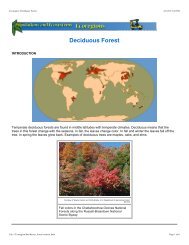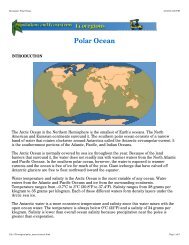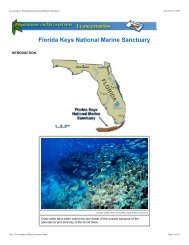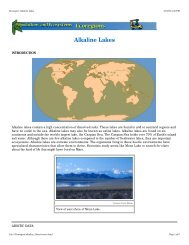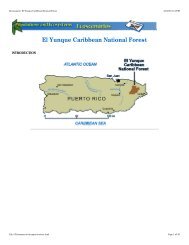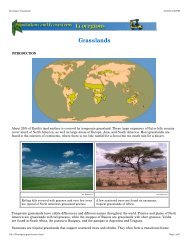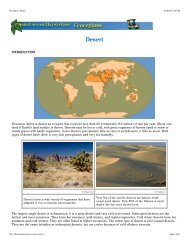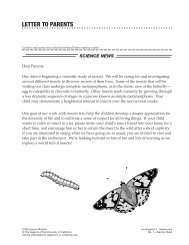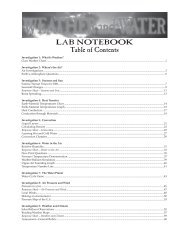Ecoscenarios Combined - FOSSweb
Ecoscenarios Combined - FOSSweb
Ecoscenarios Combined - FOSSweb
You also want an ePaper? Increase the reach of your titles
YUMPU automatically turns print PDFs into web optimized ePapers that Google loves.
Ecoscenario: Monterey Bay National Marine Sanctuary<br />
4/16/03 3:22 PM<br />
annually in the 1930s, only 5000 tons were caught each year in the 1970s. Regulations on sardine fishing have helped the<br />
population increase slowly since the mid-1980s.<br />
Limited fishing and hunting still occur in Monterey Bay National Marine Sanctuary. Several organisms, including kelp and<br />
abalone, are raised and harvested within the sanctuary. This method for farming the ocean is called mariculture.<br />
Sea otters<br />
Another concern was how the hunting of sea otters affected the kelp forest. Sea otters were hunted by Native Americans<br />
for thousands of years. In the mid-1700s Russia began hunting sea otters. Within 50 years the northern populations in<br />
Alaska were nearly eliminated. At about this time the Hudson Bay Company began hunting otters down the Pacific coast.<br />
By the 1920s only one colony existed south of Alaska, at Point Sur, California. The colony's location was kept secret by<br />
a small group of researchers. All the current California sea otters are descended from this colony.<br />
As the otters disappeared from some areas, the kelp forests also disappeared. Researchers wondered if the hunting of<br />
sea otters was related to the disappearance of kelp forests. Sea otters eat sea urchins, which in turn eat kelp. With their<br />
predator gone, sea urchin populations grew. Large numbers of urchins grazed on kelp stipes and holdfasts, clearing large<br />
areas of kelp forest. New kelp was quickly eaten by sea urchins. These kelp-free areas patrolled by sea urchins are<br />
known as urchin barrens. When sea otters returned to these areas, the kelp forest thrived again.<br />
This graph shows the number of sea otters in Monterey Bay National Marine<br />
Sanctuary from 1900 to 2000. Before sea otter hunting began in 1741, there were<br />
about 20,000 animals here.<br />
While the sea otter population along the California coast had grown to almost 2400 in 1995, in the last few years it has<br />
been declining. Sea otters are having just as many pups, but pups and adults aren't surviving as well. There are several<br />
possible causes for this decrease. About 40% of the dead sea otters found appear to have died from disease, which could<br />
be caused by increased pollution. Tissue from some dead otters had high levels of pesticides and agricultural chemicals<br />
like DDT. Oil from spills penetrates the fur, making it impossible for the underfur to stay dry. Oil and other pollution affects<br />
the populations of sea otter prey, which could impact sea otter survival as well.<br />
Accidents, such as being hit by a boat, are responsible for up to 20% of sea otter deaths. A few otters also die each year<br />
after becoming tangled in gill nets used by commercial fishers. Natural predators such as sharks also play a role. In<br />
Alaska, orca (killer whales) have recently been preying on sea otters.<br />
Researchers don't fully understand why the number of sea otters is continuing to drop.<br />
Giant kelp<br />
file:///Ecoscenario/monterey/content.html<br />
Page 11 of 14



